Contact
Dialog Netzbau
TransnetBW GmbH
Network strategy team
Pariser Platz
Osloer Straße 15-17
70173 Stuttgart, Germany
planning
Before TransnetBW can implement grid reinforcement and expansion measures, all projects undergo a legally defined series of approval procedures. You can learn more about this here.
Principles and procedures
The task of implementing the change in our energy environment, or "energy transition", is confronting us with new challenges. We must continuously adapt our extra-high voltage network to bring ever increasing amounts of electricity from renewable energy sources reliably to consumers across ever larger transmission paths. Through reinforcement measures and expansions to respond to changing demands, we can ensure reliable electricity transmission at all times. We work with the other transmission system operators involved in the Network Development Plan to design the necessary projects. Prior to implementation, all projects pass through a legally defined series of approval procedures during which the individual measures are examined in detail.
All transmission grid expansion measures must be approved by the responsible authorities before they can be put into practice. The associated procedures, which comprise several different stages, check whether the project complies with the applicable legal provisions and what impact it may have on protected resources. The aim is to consider the needs of all the different parties in depth in order to come to a solution that meets with the greatest possible widespread acceptance.
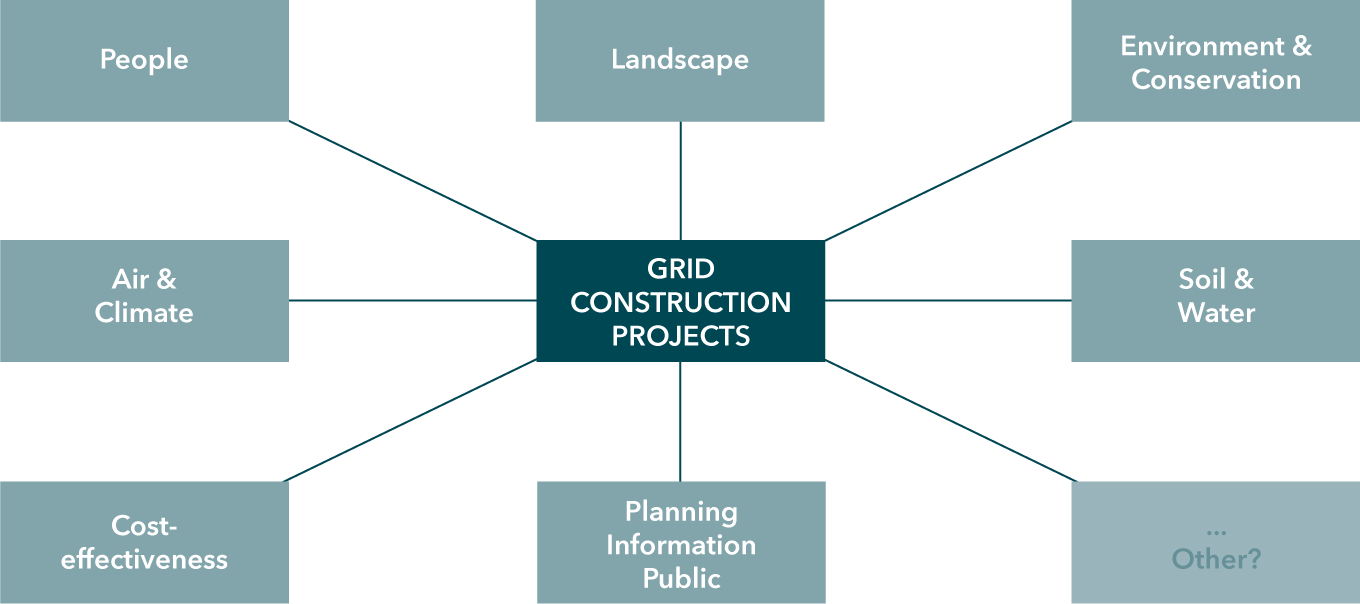
When planning and building new routes, TransnetBW adheres to the following principles:
Even before the formal approval procedures and during the entire lifetime of the project, TransnetBW engages in a comprehensive dialogue. This is because everyone affected by grid construction projects should be able to express their opinions and be listened to.

In dialogue
Do you have any questions or ideas concerning a project? Then please use the form on our project pages to get in touch with us directly.
grid construction
The AIM of the spatial planning procedure is to identify the optimum corridor for the planned measure, for example a new power line. To do this, the regional planning authority checks whether the project is compatible with regional and state planning principles. The focus during this process is placed on an all-embracing, large-scale consideration of the space. Detailed technical planning plays no role during this stage of the procedure. This only becomes important during the search for the actual transmission-line routing.
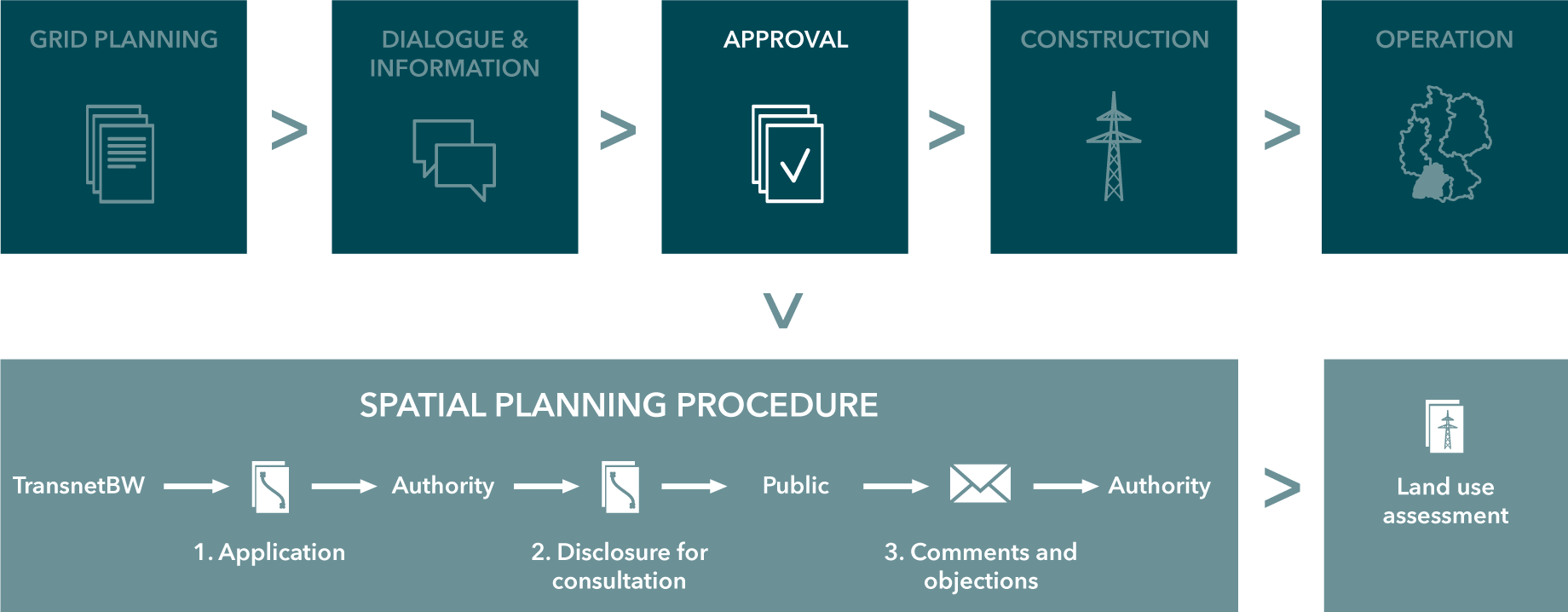
During the procedure, the project promoter (TransnetBW) submits an application proposing a number of different routing corridors.
The regional planning authority puts the documents on display in the affected municipalities and local authority areas for a period of four weeks. During this period and for two weeks afterwards, all citizens can inform the lead authority of their comments or objections regarding the project.
At the same time as the disclosure of the application documents, the approval authority also hears any public agencies concerned. These include the specialist authorities of the affected Rural District Authorities, municipalities, local authorities and associations.
The comments and objections received from the public and the results of the hearings are taken into account during planning and may, for example, lead to changes in the routing of the power lines.
The spatial planning procedure includes a land use assessment undertaken by the approval authority. This assessment identifies the most environmentally compatible route. The spatial planning procedure takes the form of a recommendation and is not legally binding. Its purpose is to guide the project promoter but involves no obligation to comply with the recommendations expressed.
AIM: During the planning approval procedure, the planned project is examined in detail. It is conducted on the basis of detailed technical and environmental studies, for example relating to the determination and verification of the definitive locations for the towers. During this procedure, as well as in the planning approval decision that follows it, all requirements and interests are considered in detail.
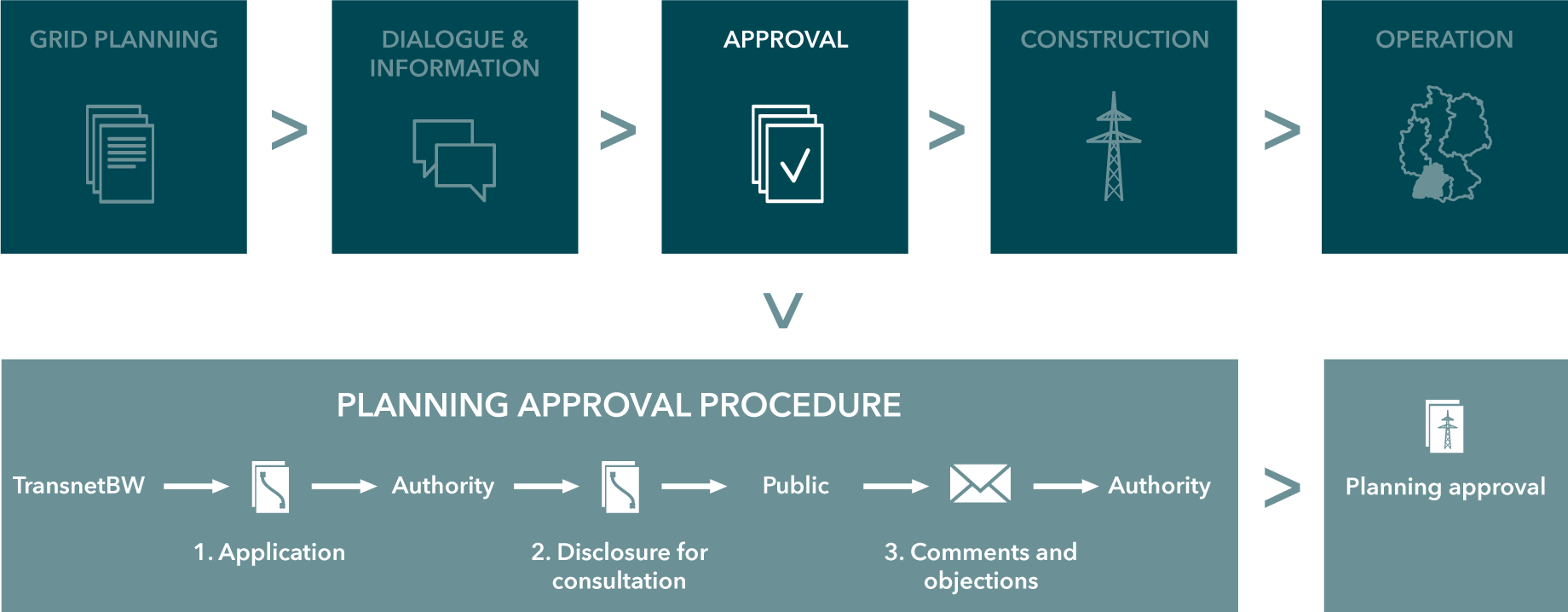
The project promoter requests the conduct of a planning approval procedure for a concrete transmission-line routing that it has developed on the basis of earlier studies.
The planning approval authority puts the documents on display in the affected municipalities and local authority areas for a period of four weeks. During this period and for two weeks afterwards, all citizens can inform the lead authority of their comments or objections regarding the project.
At the same time as the disclosure of the application documents, the approval authority also hears any public agencies concerned. These include the specialist authorities of the affected Rural District Authorities, municipalities, local authorities and associations.
The comments and objections received from the public and the results of the hearings are taken into account during planning and may, for example, lead to changes in the routing of the power lines.
Following these hearings and the public disclosure of the documents for consultation, the lead authority sets a date for a meeting to discuss the results. The purpose of this is to further discuss any objections to the planning that have been lodged in good time. Such hearings are usually not public. They are attended by the approval authority, the project promoter, the affected authorities, affected parties and other parties that have submitted written objections.
The outcome of the planning approval procedure is a planning approval decision, that is to say the legally binding approval of the project. The planning approval decision and the associated plans are made available to the affected municipalities and local authority areas. It is possible to challenge the decision. Finally, the construction work is undertaken on the basis of the planning approval decision.
grid construction
The AIM of Federal Sectoral Planning is to define a route corridor which is the subject of subsequent detailed planning. The responsible approval authority is the Federal Network Agency in Bonn.
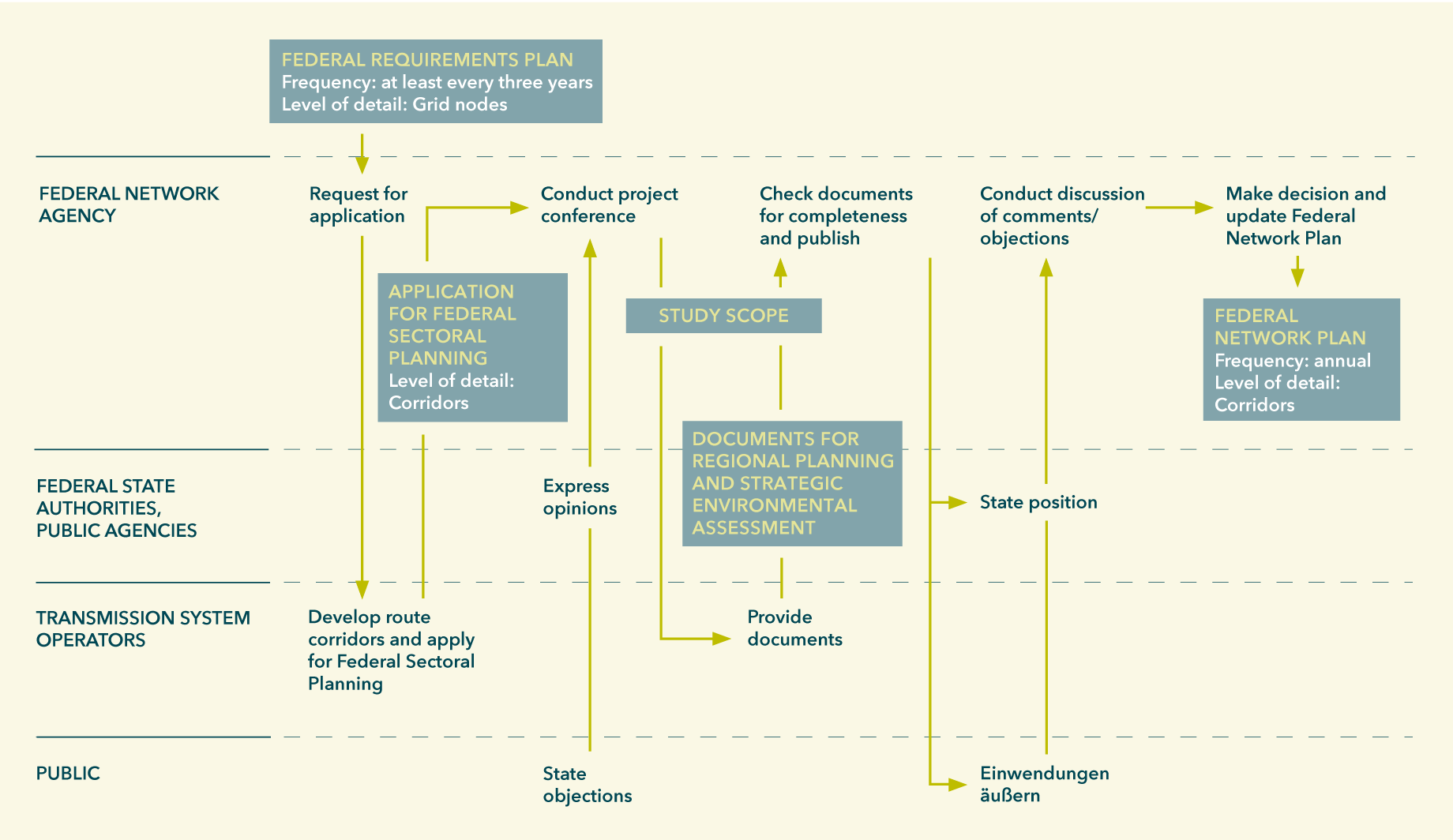
Before the project can be launched, preliminary planning must have been performed and resulted in the development of a proposal for a route corridor.
After the preliminary studies have been completed, the project promoter (TransnetBW) submits an application for Federal Sectoral Planning to the approval authority (Federal Network Agency).
The approval authority arranges one or more project conferences. It invites associations and public agencies to these. In addition, any citizen who is interested may take part. At the conference, information on the compatibility of the proposed route corridor and its alternatives with regional planning and environmental considerations is collected. After the conference, the documents and assessments still to be provided by the project promoter are defined. The requirements placed on planning are clarified as early as possible through discussions with authorities, associations and the public.
A study of compatibility with regional planning objectives, a strategic environmental assessment and other actions are conducted as part of Federal Sectoral Planning. Both of these are displayed together with the complete application documentation by the Federal Network Agency in its role as approval authority for a period of one month. During this period, as well as for the month following it, all citizens are able to inform the approval authority of their comments and objections concerning the project.
At the same time as the disclosure of the application documents, the approval authority also hears any public agencies concerned. These include the specialist authorities of the affected Rural District Authorities, municipalities, local authorities and associations.
The approval authority examines all the received comments and objections and discusses them at a public meeting involving the objecting parties, authorities, associations and the project promoter.
On conclusion of Federal Network Planning, the approval authority decides on a concrete route corridor. To do this, the authority considers all the presented arguments. The route corridor defined as the result of Federal Network Planning is binding and is taken over into the Federal Network Plan.
Aim
The planned project is carefully examined during the planning approval procedure. It is based on detailed technical and environmental analyses to identify and test specific mast locations. All concerns and interests are thoroughly evaluated during the procedure and in the subsequent planning approval decision. The German Federal Network Agency in Bonn is the responsible regulatory authority.
Preliminary planning
Comprehensive preliminary planning that includes the preparation of a proposal for the route must be completed before the project can get under way.
Application
Once the preliminary examinations have been completed, the project developer (TransnetBW) submits an application for planning approval to the regulatory authority (German Federal Network Agency).
Application conference
The regulatory authority hosts one or more application conferences. It invites associations and public bodies to these and any interested citizens are also welcome to attend. At the conference, information on the planned route and possible alternatives is collected. Following the application conference, the documents and expert opinions that the project developer will have to submit are determined. The planning requirements should be clarified as early as possible during discussions with the authorities, associations and the public.
Preparation of detailed application documents and public disclosure
On the basis of the application conferences, detailed documents on the planned measures will then be prepared as part of the planning approval procedure. This also includes an environmental impact study. As the regulatory authority, the German Federal Network Agency makes all the application documents public for one month. During this time and for one additional month, all citizens have the opportunity to submit their opinion of the project in the form of a statement to the regulatory authority.
In parallel to the public disclosure of the application documents, the regulatory authorities will hold a hearing with public bodies. These include the competent authorities of the district administrations, cities, municipalities and associations.
Public hearing
Following the hearing and public disclosure of documents, the lead authority will hold a public hearing. The purpose of this is to re-discuss objections to the planning that were raised in a timely manner.
Planning approval decision
The planning approval procedure leads into the planning approval decision, i.e. legally binding permission for the project. The planning approval decision and the plans associated with it are put on display in the cities and municipalities concerned. Legal action may be filed against the decision. Finally, the building work is carried out on the basis of the planning approval decision.
grid construction
The project promoter (TransnetBW) submits an application for approval to the lead authority. In most cases, this is the Rural District Authority.
The authority examines the documents and decides immediately about whether to issue a license. Although the legislation does not require public participation during this procedure, public consultation is possible if the authority considers it of value. The decision on the award of the licence is final.
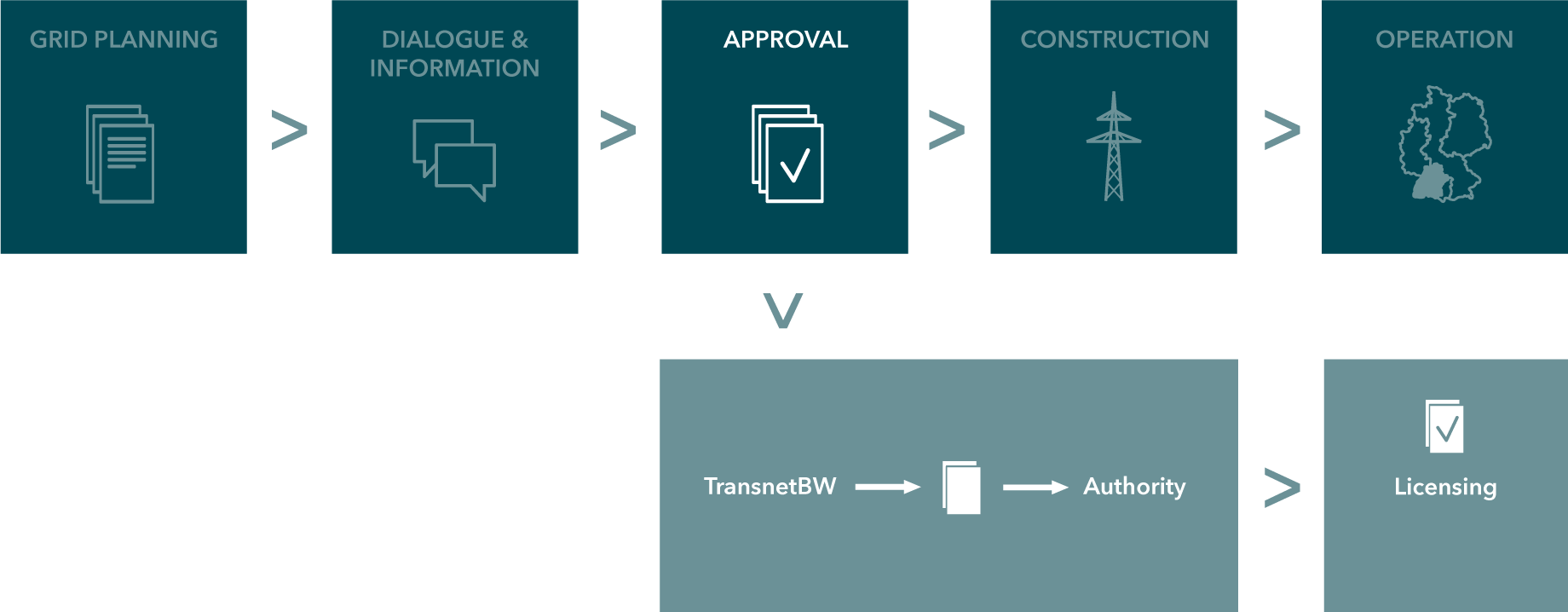
grid construction
During the planning and development of extra-high voltage lines, TransnetBW's activities impact on land owned by third-parties – for example, because lines pass over it or because towers are built on it. To permit this permanent use of their land, the property owners must accord TransnetBW the corresponding power line right of way. This is achieved through the conclusion of so-called easements agreement between the property owner and TransnetBW. The agreements set out details such as the question of who benefits from the authorisations, what the corresponding rights are and what limitations the passage of the power lines entails.
An easement agreement therefore restricts the ability of owners to make full use of their land by conferring rights on other authorised parties. They are entered in the land register for the corresponding owner and thus guarantee the continued right of the beneficiary, in this case TransnetBW, to use the land even in the case of a change of ownership. The property owner is paid compensation in exchange for agreeing to the easement.
TransnetBW GmbH
Network strategy team
Pariser Platz
Osloer Straße 15-17
70173 Stuttgart, Germany